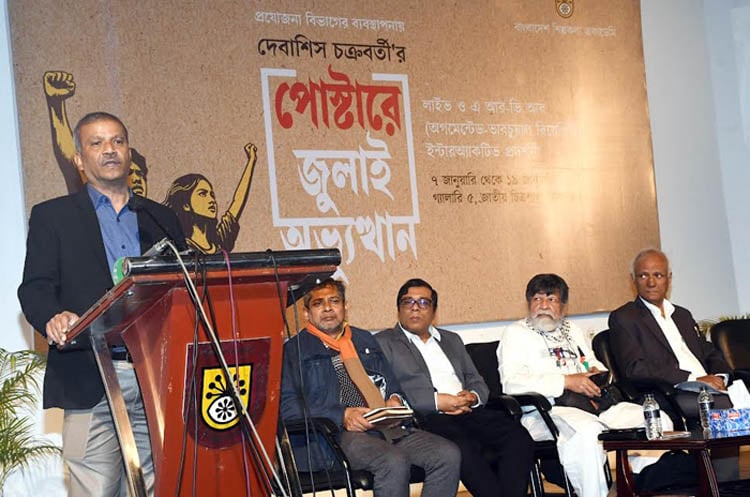News Flash
News Flash

DHAKA, Jan 7, 2025 (BSS) - Law, Justice and Parliamentary Affairs Adviser Dr Asif Nazrul today said through the July revolution Bangladesh has witnessed that only a small poster may have enormous strength to destroy a narrative remained dominant for years and it also can help build new narrative.
“A single poster can destroy the narrative in pieces which remain dominant for years and help build a strong and effective new narrative. During the July revolution, we saw how powerful and effective graffiti can be”, said Asif Nazrul.
The adviser was addressing the inaugural ceremony of Artists Debasish Chakrabarty’s poster exhibition titled ‘July Uprising in Poster’ at National Art Gallery auditorium of Bangladesh Shilpakala Academy.
Asif said along with sacrifices, hardship and sleepless nights, the innovation in each move and decision during the July uprising played a significant role in making it a success.
“We didn’t come to know that graffiti can be that much powerful during the political movement in the last 15 years. But our youth opened a new horizon in this regard using it in an exceptional way”, he said.
From naming the programme to painting graffiti or making posters, the language of movement was so basic that the fascist, conventional narrative builder, even failed to identify the opportunities to destroy it, he said, adding, “The exceptional and basic language of conducting movement played a significant role to make our July revolution successful”.
The adviser said, “During the fascist regime, we witnessed how nasty and at the same time how strong the tactics of building narratives are. The fascist regime used to give us the concept that Bangladesh is about to be developed like Singapore but in reality, those remarks are nothing but falsehood”.
Bangladesh Shilpakala Academy Director General Syed Jamil Ahmed Debasish in his artworks precisely showed how arts can simultaneously be a political weapon and artwork as well as what are the responsibilities of an artist.
Debasish, in his artwork, showed very precisely what should be the language of artworks in the post-uprising period, Jamil Ahmed added.
Managing Director and Chief Editor of Bangladesh Sangbad Sangstha (BSS) Mahbub Morshed put emphasis on highlighting and preserving the artworks and graffiti which reflected people’s voice and feelings during the student-led July uprising.
“We should preserve and appreciate the artists and artworks that conveyed the voice of the masses during the revolution as most of the artists didn’t come out from their comfort zone and didn’t raise voice against the dictatorial rule and crimes committed by the fascist regime during the movement”, he said.
Bangladeshi photographer and rights activist Shahidul Alam said, “I don’t think the artist is not only meant for arts and aesthetic works but they have more things to do”. It is not clear to me how an artwork would be worthy if its creator doesn’t raise his or her voice, he added.
Bangladesh Shilpakala Academy fine arts director Mostafa Zaman, author and researcher Parvez Alam and Bangladesh Shilpakala Academy production department director Abdul Halim Chanchal also addressed on the occasion.
Artists Debasish Chakrabarty joined the inaugural session virtually.
The live and RVR interactive exhibition will remain open for all till January 19, every day from 11am to 8pm at 5th gallery of Jatiya Chitrashala Bhaban of Bangladesh Shilpakala Academy.